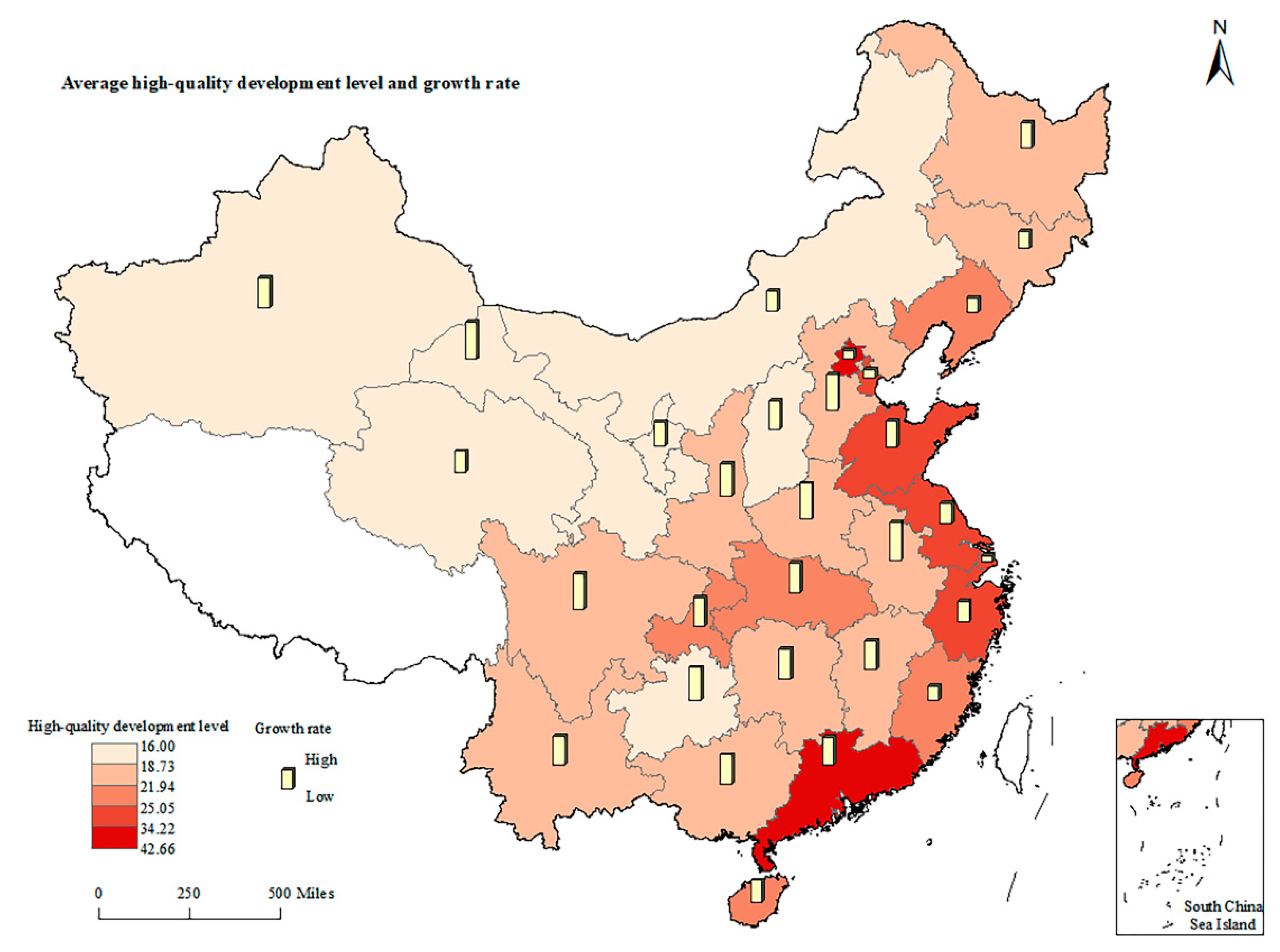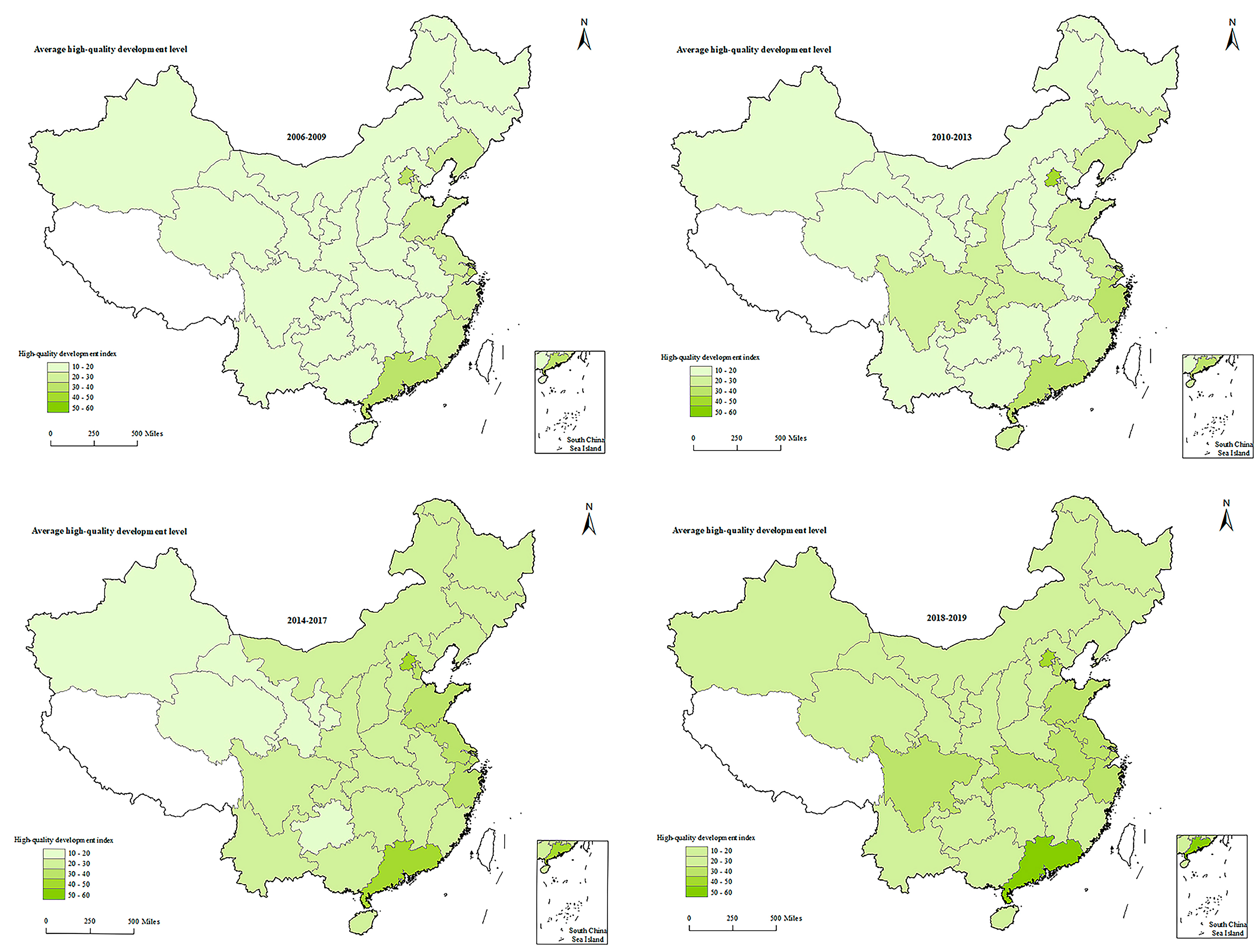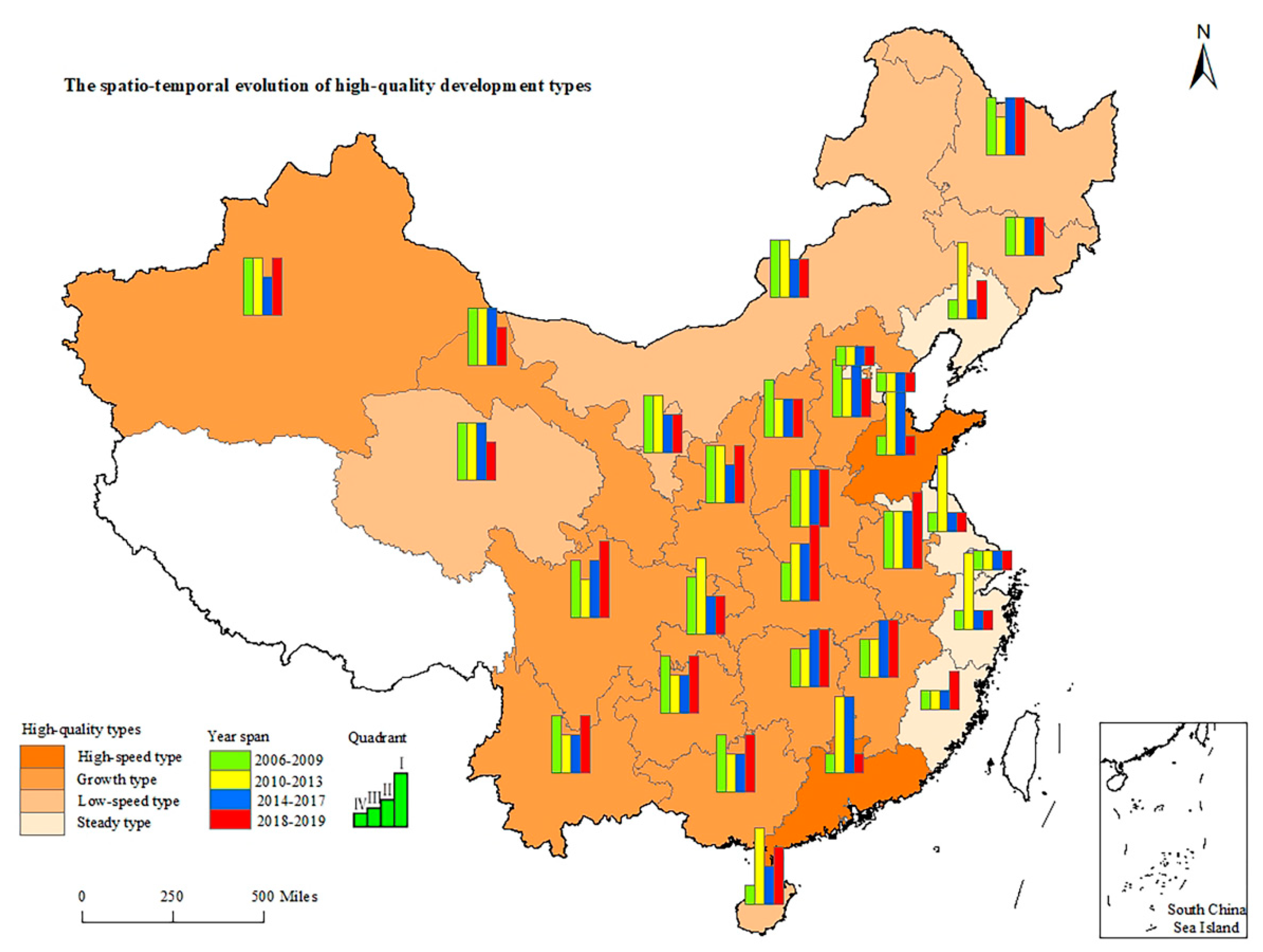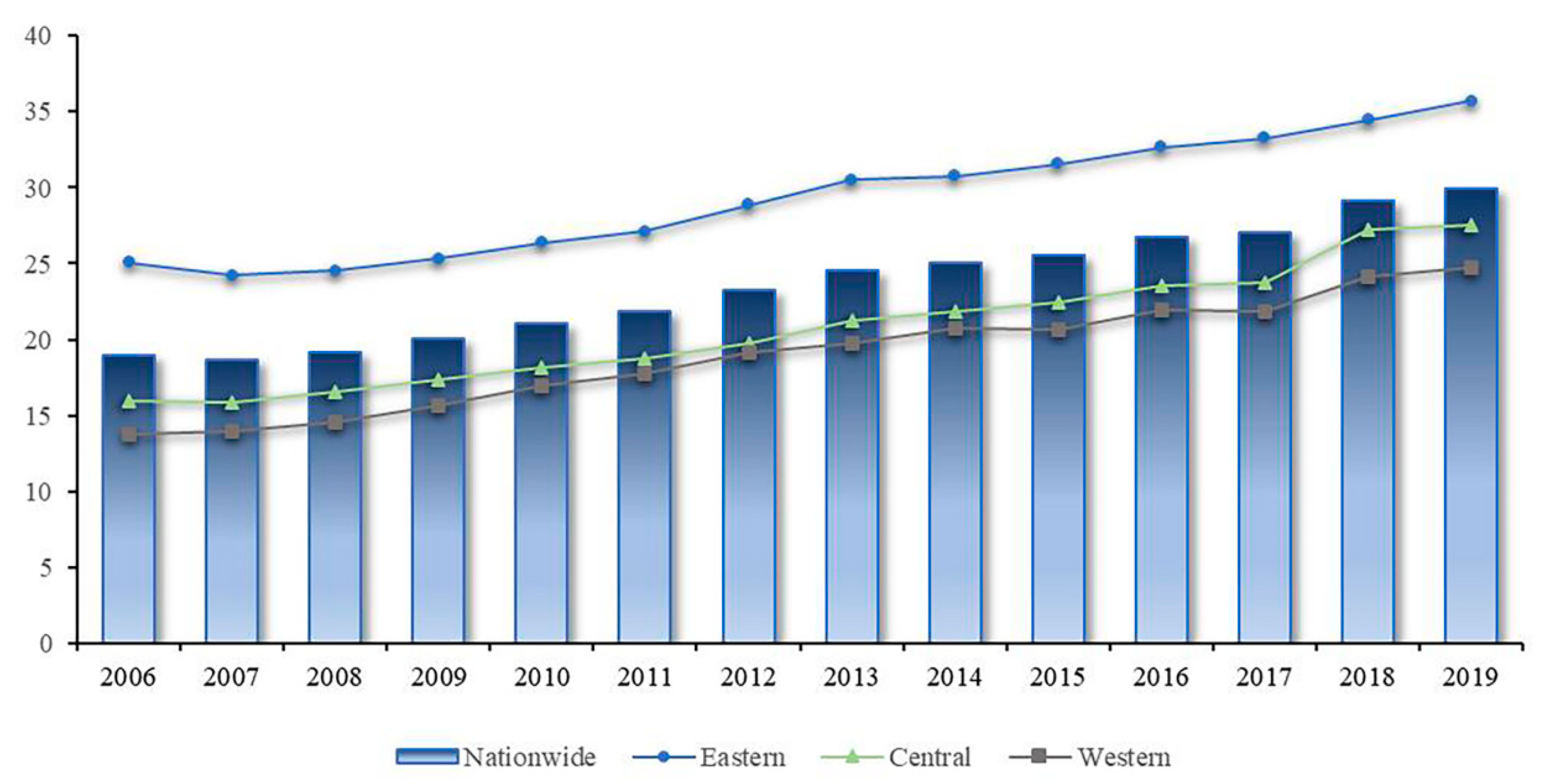Spatio-Temporal Evolution of High-Quality Development and the Impact of Carbon Emissions Trading Schemes
Abstract
:1. Introduction
2. Literature Review
2.1. The Policy Background of ETS
2.2. The Policy Effects of ETS
2.3. The Meaning and Measurement of HQD
2.4. The Influencing Factors of HQD
3. Methodology and Data
3.1. Methodology
3.1.1. Measurement of High-Quality Development Levels
3.1.2. Evolutionary Analysis of Heterogeneity Characteristics
3.1.3. Difference-in-Differences Model
3.2. Data
4. Results and Discussion
4.1. Test Results of HQD Level
4.1.1. Provincial Levels of HQD and Spatial and Temporal Patterns
4.1.2. Temporal Evolution-Type Heterogeneity
4.1.3. Regional Heterogeneity
4.2. Effects of ETS on HQD
4.2.1. Results of the Baseline Analysis
4.2.2. Robustness Test
4.2.3. Heterogeneity Analysis Results
5. Conclusions and Policy Implications
5.1. Conclusions
- (1)
- This study found that HQD levels continued to increase over the sample period, with the national average HQD index rising from 18.95 to 29.96, an increase of 58.1%. In addition, the average growth rate of HQD remained positive in all 30 Chinese provinces. The level of HQD in most provinces showed a transition from low to high and then stabilization.
- (2)
- There is remarkable spatio-temporal heterogeneity in HQD levels. In the time dimension, only nine provinces in the country had an HQD index above 20 from 2006 to 2009, while the average HQD index was above 20 in all provinces in 2018 and 2019, with HQD levels in all provinces increasing over time. In the spatial dimension, the HQD shows a clear regional diversity. The highest HQD indices in the eastern, central and western regions were 35.67, 27.52 and 24.78, respectively. The eastern HQD level was much higher than that in the central and western regions.
- (3)
- ETS can significantly improve HQD levels. This study passed the parallel trend test, considered lagged effects, excluded environmental interference and replaced evaluation variables or models whose results remained significant. Further analysis of the regional heterogeneity of ETS policy reveals that ETS does not have a significant impact on the western region. ETS has greatly increased HQD levels in the eastern and central regions.
5.2. Policy Implications
Author Contributions
Funding
Institutional Review Board Statement
Informed Consent Statement
Data Availability Statement
Conflicts of Interest
References
- Heidari, N.; Pearce, J.M. A review of greenhouse gas emission liabilities as the value of renewable energy for mitigating lawsuits for climate change related damages. Renew. Sustain. Energy Rev. 2016, 55, 899–908. [Google Scholar] [CrossRef]
- Dino, I.G.; Akgül, C.M. Impact of climate change on the existing residential building stock in Turkey: An analysis on energy use, greenhouse gas emissions and occupant comfort. Renew. Energy 2019, 141, 828–846. [Google Scholar] [CrossRef]
- Rehman, A.; Ma, H.; Ahmad, M.; Irfan, M.; Traore, O.; Chandio, A.A. Towards environmental Sustainability: Devolving the influence of carbon dioxide emission to population growth, climate change, Forestry, livestock and crops production in Pakistan. Ecol. Indic. 2021, 125, 107460. [Google Scholar] [CrossRef]
- Xi, J.P. Xi Jinping’s Speech at the Climate Ambition Summit. 2020. Available online: http://www.gov.cn/xinwen/2020-12/13/content_5569138.htm. (accessed on 20 May 2022).
- Wang, Q.; Hao, D.; Li, F.; Guan, X.; Chen, P. Development of a new framework to identify pathways from socioeconomic development to environmental pollution. J. Clean. Prod. 2020, 253, 119962. [Google Scholar] [CrossRef]
- Yuan, H.; Zhang, T.; Hu, K.; Feng, Y.; Feng, C.; Jia, P. Influences and transmission mechanisms of financial agglomeration on environmental pollution. J. Environ. Manag. 2021, 303, 114136. [Google Scholar] [CrossRef]
- Sun, C.; Tong, Y.; Zou, W. The evolution and a temporal-spatial difference analysis of green development in China. Sustain. Cities Soc. 2018, 41, 52–61. [Google Scholar] [CrossRef]
- Sun, Y.; Wang, N. Sustainable urban development of the π-shaped Curve Area in the Yellow River basin under ecological constraints: A study based on the improved ecological footprint model. J. Clean. Prod. 2022, 337, 130452. [Google Scholar] [CrossRef]
- Liu, J.; Zhang, L.; Zhang, N. Analyzing the South-North Gap in the High-Quality Development of China’s Urbanization. Sustainability 2022, 14, 2178. [Google Scholar] [CrossRef]
- Du, J.; Zhang, J.; Li, X. What Is the Mechanism of Resource Dependence and High-Quality Economic Development? An Empirical Test from China. Sustainability 2020, 12, 8144. [Google Scholar] [CrossRef]
- Liu, R.; Guo, T. Construction and Application of the High-quality Development Index—Also on the High-quality Development of Northeast China’s Economy. J. Northeast. Univ. (Soc. Sci.) 2020, 22, 31. (In Chinese) [Google Scholar] [CrossRef]
- Li, X.; Lu, Y.; Huang, R. Whether foreign direct investment can promote high-quality economic development under environmental regulation: Evidence from the Yangtze River Economic Belt, China. Environ. Sci. Pollut. Res. 2021, 28, 21674–21683. [Google Scholar] [CrossRef]
- Yang, G.; Deng, F.; Wang, Y.; Xiang, X. Digital Paradox: Platform Economy and High-Quality Economic Development—New Evidence from Provincial Panel Data in China. Sustainability 2022, 14, 2225. [Google Scholar] [CrossRef]
- ICAP. Emissions Trading Worldwide: Status Report 2022; International Carbon Action Partnership: Berlin, Germany, 2022. [Google Scholar]
- Mehling, M.; Haites, E. Mechanisms for linking emissions trading schemes. Clim. Policy 2009, 9, 169–184. [Google Scholar] [CrossRef]
- Chengping, C.; Xu, Z. A Study on the Construction of China’s Carbon EmissionsTrading System. Energy Procedia 2011, 5, 1037–1043. [Google Scholar] [CrossRef]
- Liu, L.; Chen, C.; Zhao, Y.; Zhao, E. China׳s carbon-emissions trading: Overview, challenges and future. Renew. Sustain. Energy Rev. 2015, 49, 254–266. [Google Scholar] [CrossRef]
- Perino, G.; Willner, M. Procrastinating reform: The impact of the market stability reserve on the EU ETS. J. Environ. Econ. Manag. 2016, 80, 37–52. [Google Scholar] [CrossRef]
- Lin, B.; Jia, Z. What are the main factors affecting carbon price in Emission Trading Scheme? A case study in China. Sci. Total Environ. 2019, 654, 525–534. [Google Scholar] [CrossRef] [PubMed]
- Wu, R.; Qin, Z. Assessing market efficiency and liquidity: Evidence from China’s emissions trading scheme pilots. Sci. Total Environ. 2021, 769, 144707. [Google Scholar] [CrossRef]
- Zhang, Y.-J.; Wei, Y.-M. An overview of current research on EU ETS: Evidence from its operating mechanism and economic effect. Appl. Energy 2010, 87, 1804–1814. [Google Scholar] [CrossRef]
- Wang, K.; Wei, Y.-M.; Huang, Z. Potential gains from carbon emissions trading in China: A DEA based estimation on abatement cost savings. Omega 2016, 63, 48–59. [Google Scholar] [CrossRef]
- Zhang, Y.-J.; Peng, Y.-L.; Ma, C.-Q.; Shen, B. Can environmental innovation facilitate carbon emissions reduction? Evidence from China. Energy Policy 2017, 100, 18–28. [Google Scholar] [CrossRef]
- Dong, F.; Dai, Y.; Zhang, S.; Zhang, X.; Long, R. Can a carbon emission trading scheme generate the Porter effect? Evidence from pilot areas in China. Sci. Total. Environ. 2019, 653, 565–577. [Google Scholar] [CrossRef] [PubMed]
- Li, X.; Shu, Y.; Jin, X. Environmental regulation, carbon emissions and green total factor productivity: A case study of China. Environ. Dev. Sustain. 2022, 24, 2577–2597. [Google Scholar] [CrossRef]
- Yan, Y.; Zhang, X.; Zhang, J.; Li, K. Emissions trading system (ETS) implementation and its collaborative governance effects on air pollution: The China story. Energy Policy 2020, 138, 111282. [Google Scholar] [CrossRef]
- Zhang, H.; Duan, M. China’s pilot emissions trading schemes and competitiveness: An empirical analysis of the provincial industrial sub-sectors. J. Environ. Manag. 2020, 258, 109997. [Google Scholar] [CrossRef]
- Zhou, F.; Wang, X. The carbon emissions trading scheme and green technology innovation in China: A new structural economics perspective. Econ. Anal. Policy 2022, 74, 365–381. [Google Scholar] [CrossRef]
- Qi, S.-Z.; Zhou, C.-B.; Li, K.; Tang, S.-Y. The impact of a carbon trading pilot policy on the low-carbon international competitiveness of industry in China: An empirical analysis based on a DDD model. J. Clean. Prod. 2021, 281, 125361. [Google Scholar] [CrossRef]
- Xiao, J.; Li, G.; Zhu, B.; Xie, L.; Hu, Y.; Huang, J. Evaluating the impact of carbon emissions trading scheme on Chinese firms’ total factor productivity. J. Clean. Prod. 2021, 306, 127104. [Google Scholar] [CrossRef]
- Dai, Y.; Li, N.; Gu, R.; Zhu, X. Can China’s Carbon Emissions Trading Rights Mechanism Transform its Manufacturing Industry? Based on the Perspective of Enterprise Behavior. Sustainability 2018, 10, 2421. [Google Scholar] [CrossRef]
- Mei, L.; Chen, Z. The Convergence Analysis of Regional Growth Differences in China: The Perspective of the Quality of Economic Growth*. J. Serv. Sci. Manag. 2016, 09, 453–476. [Google Scholar] [CrossRef] [Green Version]
- Jin, B. Economics research on “high-quality development. China Ind. Econ. 2018, 4, 5–18. (In Chinese) [Google Scholar] [CrossRef]
- Li, D.; Hu, S. How does Technological Innovation Mediate the Relationship between Environmental Regulation and High-Quality Economic Development?: Empirical Evidence from China. Sustainability 2021, 13, 2231. [Google Scholar] [CrossRef]
- Li, C.; Wan, J.; Xu, Z.; Lin, T. Impacts of Green Innovation, Institutional Constraints and Their Interactions on High-Quality Economic Development across China. Sustainability 2021, 13, 5277. [Google Scholar] [CrossRef]
- Barro, R.J. Quantity and Quality of Economic Growth; Banco Central de Chile: Santiago, Chile, 2002. [Google Scholar]
- Mlachila, M.; Tapsoba, R.; Tapsoba, S.J.A. A Quality of Growth Index for Developing Countries: A Proposal. Soc. Indic. Res. 2016, 134, 675–710. [Google Scholar] [CrossRef]
- Held, B.; Rodenhäuser, D.; Diefenbacher, H.; Zieschank, R. The National and Regional Welfare Index (NWI/RWI): Redefining Progress in Germany. Ecol. Econ. 2018, 145, 391–400. [Google Scholar] [CrossRef]
- He, X.Y.; Shen, K.R. Modern economic system, full factor productivity and high-quality development. Shanghai Econ. Res. 2018, 6, 25–34. (In Chinese) [Google Scholar] [CrossRef]
- Chen, S.Y.; Chen, D.K. Air Pollution, Government regulations and High-quality Economic Development. Econ. Res. 2018, 53, 20–34. (In Chinese) [Google Scholar]
- Liu, P.; Zhu, B.; Yang, M. Has marine technology innovation promoted the high-quality development of the marine economy?—Evidence from coastal regions in China. Ocean Coast. Manag. 2021, 209, 105695. [Google Scholar] [CrossRef]
- Kong, Q.; Peng, D.; Ni, Y.; Jiang, X.; Wang, Z. Trade openness and economic growth quality of China: Empirical analysis using ARDL model. Finance Res. Lett. 2020, 38, 101488. [Google Scholar] [CrossRef]
- Huang, X.; Cai, B.; Li, Y. Evaluation Index System and Measurement of High-quality Development in China. Rev. Cercet. Interv. Sociala 2020, 68, 163–178. [Google Scholar] [CrossRef]
- Ding, C.; Liu, C.; Zheng, C.; Li, F. Digital Economy, Technological Innovation and High-Quality Economic Development: Based on Spatial Effect and Mediation Effect. Sustainability 2021, 14, 216. [Google Scholar] [CrossRef]
- Wang, F.; Wang, R.; He, Z. The impact of environmental pollution and green finance on the high-quality development of energy based on spatial Dubin model. Resour. Policy 2021, 74, 102451. [Google Scholar] [CrossRef]
- Shi, Z.; Xu, D.; Xu, L. Spatiotemporal characteristics and impact mechanism of high-quality development of cultural tourism in the Yangtze River Delta urban agglomeration. PLoS ONE 2021, 16, e0252842. [Google Scholar] [CrossRef] [PubMed]
- Wang, H.; Li, B. Environmental regulations, capacity utilization, and high-quality development of manufacturing: An analysis based on Chinese provincial panel data. Sci. Rep. 2021, 11, 1–13. [Google Scholar] [CrossRef] [PubMed]
- Wei, M.; Li, S.H. Study on the Measurement of Economic High-Quality Development Level in China in the New Era. Quant. Tech. Econ. 2018, 35, 3–20. (In Chinese) [Google Scholar] [CrossRef]
- Lu, B.K.; Xing, M.Y.; Yang, Q.L. Measurement and Spatio-temporal Differences Analysis of High Quality Development Level of China’s Economy. Stat. Decis. 2019, 35, 113–117. (In Chinese) [Google Scholar] [CrossRef]
- Ji, Y.; Huang, G.H.; Sun, W. Risk assessment of hydropower stations through an integrated fuzzy entropy-weight multiple criteria decision making method: A case study of the Xiangxi River. Expert Syst. Appl. 2015, 42, 5380–5389. [Google Scholar] [CrossRef]
- Chen, M.; Liu, W.; Tao, X. Evolution and assessment on China’s urbanization 1960–2010: Under-urbanization or over-urbanization? Habitat Int. 2013, 38, 25–33. [Google Scholar] [CrossRef]
- Shen, L.; Peng, Y.; Zhang, X.; Wu, Y. An alternative model for evaluating sustainable urbanization. Cities 2012, 29, 32–39. [Google Scholar] [CrossRef]
- Zhang, H.; Li, S. Carbon emissions’ spatial-temporal heterogeneity and identification from rural energy consumption in China. J. Environ. Manag. 2022, 304, 114286. [Google Scholar] [CrossRef]
- Li, J.; Lin, B. Environmental impact of electricity relocation: A quasi-natural experiment from interregional electricity transmission. Environ. Impact Assess. Rev. 2017, 66, 151–161. [Google Scholar] [CrossRef]
- Huang, Z.; Du, X. Toward green development? Impact of the carbon emissions trading system on local governments’ land supply in energy-intensive industries in China. Sci. Total. Environ. 2020, 738, 139769. [Google Scholar] [CrossRef] [PubMed]
- Lu, X.; Kuang, B.; Li, J. Regional difference decomposition and policy implications of China’s urban land use efficiency under the environmental restriction. Habitat Int. 2018, 77, 32–39. [Google Scholar] [CrossRef]
- Wang, Q.; Zhao, C. Regional difference and driving factors of industrial carbon emissions performance in China. Alex. Eng. J. 2021, 60, 301–309. [Google Scholar] [CrossRef]
- Liu, H.; Wang, C.; Tian, M.; Wen, F. Analysis of regional difference decomposition of changes in energy consumption in China during 1995–2015. Energy 2019, 171, 1139–1149. [Google Scholar] [CrossRef]
- Lu, S.; Shen, J.H.; Li, W.; Zhang, J. A theory of economic development and dynamics of Chinese economy. Econ. Model. 2020, 86, 69–87. [Google Scholar] [CrossRef]
- Zhang, Z.; Zhang, J.; Feng, Y. Assessment of the Carbon Emission Reduction Effect of the Air Pollution Prevention and Control Action Plan in China. Int. J. Environ. Res. Public Health 2021, 18, 13307. [Google Scholar] [CrossRef]
- Yu, D.-J.; Li, J. Evaluating the employment effect of China’s carbon emission trading policy: Based on the perspective of spatial spillover. J. Clean. Prod. 2021, 292, 126052. [Google Scholar] [CrossRef]
- Yan, Z.; Zou, B.; Du, K.; Li, K. Do renewable energy technology innovations promote China’s green productivity growth? Fresh evidence from partially linear functional-coefficient models. Energy Econ. 2020, 90, 104842. [Google Scholar] [CrossRef]
- Zhu, B.; Zhang, M.; Huang, L.; Wang, P.; Su, B.; Wei, Y.-M. Exploring the effect of carbon trading mechanism on China’s green development efficiency: A novel integrated approach. Energy Econ. 2020, 85, 104601. [Google Scholar] [CrossRef]
- Ogunpaimo, O.R.; Oyetunde-Usman, Z.; Surajudeen, J. Impact of Climate Change Adaptation on Household Food Security in Nigeria-a Difference-in-Difference Approach. Sustainability 2021, 13, 1444. [Google Scholar] [CrossRef]






| Variables | Definition | Obs | Mean | Std. Dev. | Min | Max |
|---|---|---|---|---|---|---|
| HQD | High-quality development index | 420 | 16.85 | 8.39 | 6.86 | 55.92 |
| lnpop | Logarithmic population | 420 | 8.19 | 0.74 | 6.31 | 9.35 |
| industry | The proportion of added value of the secondary industry in GDP | 420 | 43.56 | 8.41 | 16.2 | 62 |
| energy | energy intensity | 420 | 1.43 | 0.93 | 0.47 | 5.62 |
| lnep | Logarithm of industrial enterprises above designated size | 420 | 8.82 | 1.21 | 5.81 | 11.09 |
| Variables | Model 1 | Model 2 |
|---|---|---|
| Treated × Period | 5.782 *** (7.61) | 1.836 *** (3.38) |
| lnpop | −9.445 *** (−2.63) | |
| industry | −0.0420 (−1.07) | |
| energy | 2.078 *** (3.27) | |
| lnep | 2.319 *** (3.88) | |
| _cons | 16.35 *** (90.64) | 69.22 ** (2.26) |
| Control variable | No | Yes |
| Province fixed effects | No | Yes |
| Year fixed effects | No | Yes |
| Observations | 420 | 420 |
| R-squared | 0.129 | 0.724 |
| Variables | Model 1 | Model 2 |
|---|---|---|
| Treated × time | 1.527 *** (2.81) | 1.414 ** (2.53) |
| lnpop | −5.123 (−1.29) | −4.049 (−0.88) |
| industry | −0.0433 (−1.04) | −0.0368 (−0.83) |
| energy | 2.269 *** (3.24) | 2.230 *** (2.82) |
| lnep | 2.098 *** (3.35) | 2.134 *** (3.26) |
| _cons | 34.33 (1.02) | 25.23 (0.66) |
| Control variable | Yes | Yes |
| Province fixed effects | Yes | Yes |
| Year fixed effects | Yes | Yes |
| Observations | 390 | 360 |
| R-squared | 0.737 | 0.729 |
| Variables | Model 1 | Model 2 | Model 3 |
|---|---|---|---|
| Treated × time | 2.374 *** (3.64) | 6.563 *** (9.25) | 1.240 ** (2.49) |
| lnpop | −8.958 ** (−2.16) | 7.156 (1.35) | −10.43 *** (−2.95) |
| industry | −0.0121 (−0.25) | −0.104 *** (−2.80) | −0.00254 (−0.08) |
| energy | 1.845 ** (2.23) | 1.399 ** (2.39) | 0.948 * (1.84) |
| lnep | 2.469 *** (3.33) | 1.259 ** (2.16) | 1.270 ** (2.03) |
| _cons | 62.01 * (1.79) | −55.21 (−1.27) | 83.43 *** (2.75) |
| Control variable | Yes | Yes | Yes |
| Province fixed effects | Yes | Yes | Yes |
| Year fixed effects | Yes | Yes | Yes |
| Observations | 280 | 364 | 266 |
| R-squared | 0.663 | 0.800 | 0.827 |
| Variables | Model 1 | Model 2 | Model 3 | Model 4 |
|---|---|---|---|---|
| Treated × time | 2.204 *** (4.02) | 0.345 *** (10.86) | 2.606 *** (3.81) | 0.0561 *** (3.40) |
| lnpop | −11.19 *** (−3.05) | 0.639 *** (3.04) | −4.224 (−0.85) | −0.242 ** (−2.22) |
| industry | −0.0427 (−1.09) | 0.00255 (1.11) | −0.264 *** (−4.78) | −0.000960 (−0.80) |
| energy | 2.100 *** (3.32) | 0.00467 (0.13) | 5.892 *** (4.72) | 0.0292 (1.52) |
| lnep | 2.372 *** (3.99) | −0.310 *** (−8.86) | 4.348 *** (5.50) | 0.0610 *** (3.36) |
| _cons | 82.95 *** (2.66) | −1.399 (−0.78) | 13.50 (0.32) | 1.269 (1.36) |
| Control variable | Yes | Yes | Yes | Yes |
| Province fixed effects | Yes | Yes | Yes | Yes |
| Year fixed effects | Yes | Yes | Yes | Yes |
| Observations | 420 | 420 | 295 | 420 |
| R-squared | 0.728 | 0.684 | 0.768 | 0.895 |
| Variables | Model 1 | Model 2 | Model 3 |
|---|---|---|---|
| Treated × time | 2.209 ** (2.18) | 1.877 *** (3.00) | 0.327 (0.45) |
| lnpop | −10.13 * (−1.68) | 18.61 ** (2.55) | −30.49 *** (−4.57) |
| industry | −0.171 (−1.52) | −0.00584 (−0.19) | −0.166 ** (−2.62) |
| energy | 3.922 (1.40) | 0.333 (0.39) | 0.939 (1.36) |
| lnep | 7.625 *** (5.83) | 4.837 *** (5.81) | 0.827 (0.73) |
| _cons | 35.27 (0.67) | −187.3 *** (−2.99) | 244.8 *** (4.86) |
| Control variable | Yes | Yes | Yes |
| Province fixed effects | Yes | Yes | Yes |
| Year fixed effects | Yes | Yes | Yes |
| Observations | 168 | 126 | 126 |
| R-squared | 0.718 | 0.911 | 0.852 |
Disclaimer/Publisher’s Note: The statements, opinions and data contained in all publications are solely those of the individual author(s) and contributor(s) and not of MDPI and/or the editor(s). MDPI and/or the editor(s) disclaim responsibility for any injury to people or property resulting from any ideas, methods, instructions or products referred to in the content. |
© 2023 by the authors. Licensee MDPI, Basel, Switzerland. This article is an open access article distributed under the terms and conditions of the Creative Commons Attribution (CC BY) license (https://creativecommons.org/licenses/by/4.0/).
Share and Cite
Cao, R.; Xiao, Y.; Yin, F. Spatio-Temporal Evolution of High-Quality Development and the Impact of Carbon Emissions Trading Schemes. Sustainability 2023, 15, 2900. https://doi.org/10.3390/su15042900
Cao R, Xiao Y, Yin F. Spatio-Temporal Evolution of High-Quality Development and the Impact of Carbon Emissions Trading Schemes. Sustainability. 2023; 15(4):2900. https://doi.org/10.3390/su15042900
Chicago/Turabian StyleCao, Rui, Yanling Xiao, and Fengxue Yin. 2023. "Spatio-Temporal Evolution of High-Quality Development and the Impact of Carbon Emissions Trading Schemes" Sustainability 15, no. 4: 2900. https://doi.org/10.3390/su15042900








